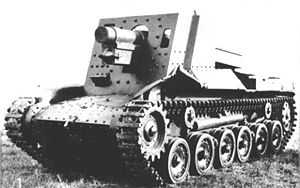Type 4 Ho-Ro
| Type 4 Ho-Ro | |
|---|---|
|
Type 4 Ho-Ro Self-Propelled Gun | |
| Type | Self-propelled artillery |
| Place of origin |
|
| Production history | |
| Number built | about 25 |
| Specifications | |
| Weight | 13.3 tons (29,260 lb) |
| Length | 5.537 meters (18 ft 2 in) |
| Width | 2.286 meters (7 ft 6 in) |
| Height | 1.549 meters (5 ft 1 in) to top of shield |
| Crew | 4 or 5 |
|
| |
| Armor | 12mm – 25mm (0.98in) |
Main armament | 150mm Type 38 howitzer |
Secondary armament | none |
| Engine |
Mitsubishi Type 100 air-cooled V-12 diesel 170 Hp (126.8 kW) |
| Power/weight | 12.8 hp/ton |
| Suspension | bell crank |
Operational range | 250 kilometers (156 miles) |
| Speed | 38 km/h (23.6 mph) |
The Type 4 15cm self-propelled gun Ho-Ro (四式十五糎自走砲 ホロ 4siki-15cm jisouhou Ho-Ro) was a self-propelled gun developed by the Imperial Japanese Army in World War II.
Development
Inspired by the Grille series of self propelled artillery vehicles developed by Nazi Germany during World War II, wherein a 15 cm sIG 33 infantry support gun was mounted on a tracked chassis, engineers at the Army Technical Bureau resolved to do the same. Production was assigned to Mitsubishi Heavy Industries. The exact number produced is uncertain, but was approximately 25 units.
Design

The chassis selected was a modified Type 97 Chi-Ha chassis. On to this platform, a Type 38 15 cm howitzer which was based on a design by the German arms-manufacturer Krupp was mounted. This gun was capable of firing a 36 kilogram shell 6,000 meters, but dated from 1905 and had been withdrawn from service as being obsolete in 1942.[1] The gun crew was protected by an open gun shield with armor thickness of 25 mm to the front, but was unprotected to the sides and rear, which made the design extremely vulnerable to close combat. Other issues with the design was that the gun had a traverse movement of only 3 degrees, and had a slow rate of fire due to its breech loader.
Service
The Type 4 was deployed in batteries of four vehicles, which saw combat with the Japanese Fourteenth Area Army during the Philippines Campaign[2] during the final months of World War II. Remaining units were deployed to Okinawa in ones and twos for island defense during the Battle of Okinawa, but were severely outnumbered by American artillery.[3]
References
- Notes
- Bibliography
- Trewhitt, Philip (1999). Armoured Fighting Vehicles. 108: Dempsey-Parr. ISBN 1-84084-328-4.
- Zaloga, Steven J. (2007). Japanese Tanks 1939-45. Osprey. ISBN 9781846030918.
External links
- World War II vehicles
- OnWar.com
- Ho-Ro Taki's Imperial Japanese Army Page
- Tanks in WWII
- Catalog of Enemy Ordnance
| ||||||||||||||||||||||||||||||
